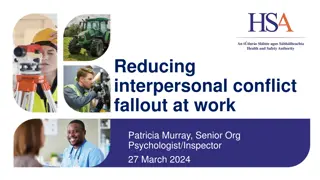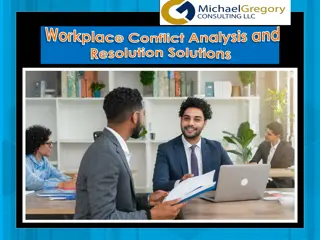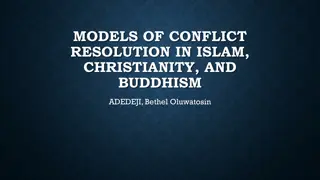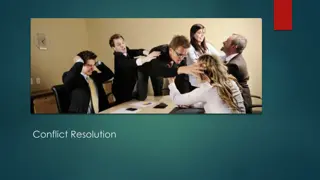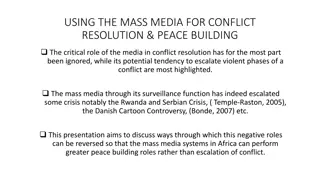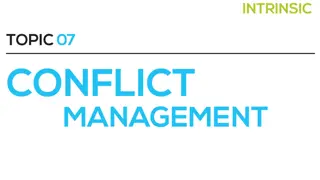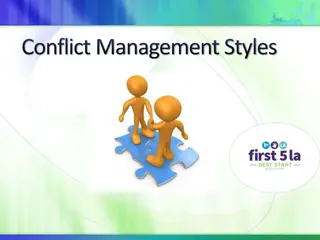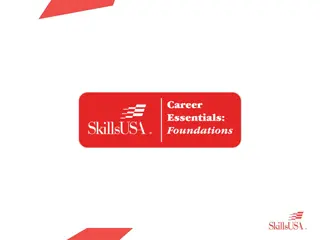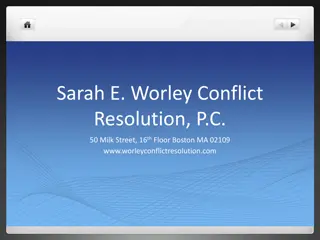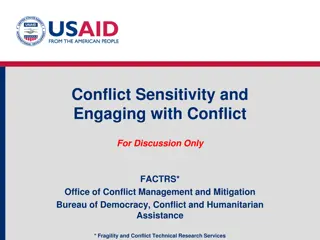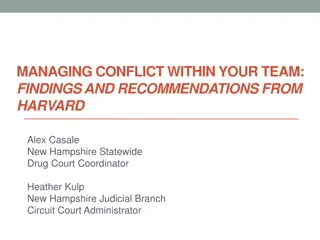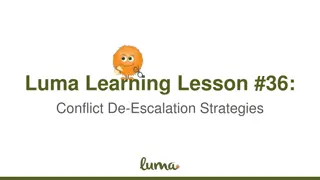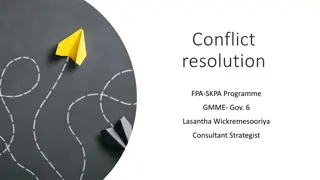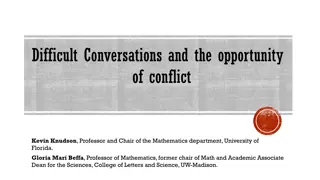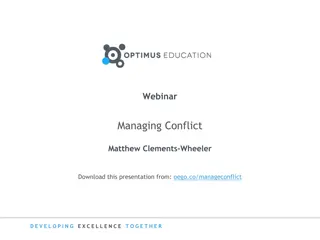Effective Conflict Resolution Strategies in the Workplace
Addressing conflicts in the workplace is essential for fostering positive relationships and a better work environment. Conflict is normal and, when managed well, can lead to growth opportunities. Understanding the fundamentals of conflict resolution, such as recognizing conflicting needs and managing emotions, is key to successful conflict resolution. By employing tools like the win-win approach and fostering a creative response mindset, conflicts can be turned into opportunities for collaboration and problem-solving.
- Conflict resolution
- Workplace relationships
- Effective communication
- Team building
- Conflict management
Download Presentation

Please find below an Image/Link to download the presentation.
The content on the website is provided AS IS for your information and personal use only. It may not be sold, licensed, or shared on other websites without obtaining consent from the author. Download presentation by click this link. If you encounter any issues during the download, it is possible that the publisher has removed the file from their server.
E N D
Presentation Transcript
CONFLICT RESOLUTION IN THE WORKPLACE Create better work climates and more fulfilling relationships
CONFLICT Normal and healthy part of relationships When mismanaged, can harm relationships When handled in a respectful and positive way, provides opportunity for growth
THE FUNDAMENTALS OF CONFLICT RESOLUTION
FUNDAMENTALS Conflict arises from differences. Values, motivations, perceptions, ideas, or desires Sometimes these differences may seem trivial to you, but when a conflict triggers strong feelings, a deep personal and relational need is at the core of the problem a need to feel safe and secure a need to feel respected and valued a need for greater closeness and intimacy.
FUNDAMENTALS Recognize the legitimacy of conflicting needs Be willing to examine them in an environment of compassionate understanding This will open pathways to creative problem solving, team building, improved relationships, and trust
FUNDAMENTALS Successful conflict resolution depends on your ability to: Manage stress while remaining alert and calm. Control your emotions and behavior. Pay attention to the feelings being expressed. Be aware of and respectful of differences.
CONFLICT RESOLUTION TOOL KIT
WIN-WIN APPROACH Cooperation I want to win and I want you to win, too. Discuss underlying needs Orange example Ask probing questions to find out needs Recognize individual differences Be open to adapting your position in light of shared information and attitudes Attack the problem, not the people
CREATIVE RESPONSE Turn problems in to possibilities Attitude colors thoughts Perfection (winners and losers) Discovery (winners and learners)
EMPATHY Information Getting a clear picture Affirmation Affirming, acknowledging, exploring the problem Inflammation Responding to a complaint or attack on you
APPROPRIATE ASSERTIVENESS When to use I statements How it is on my side, how I see it, and how I would like it to be. You need to let the other person know you are feeling strongly about the issue Others often underestimate how hurt or angry or put out you are, so it s useful to say exactly what s going on for you making the situation appear neither better nor worse.
COOPERATIVE POWER Responding to resistance from others Ask open questions to reframe resistance Find options Redirect Move to the positive Go back to legitimate needs and concerns
MANAGING EMOTIONS-HANDLING YOURSELF 5 questions Why am I feeling so angry/hurt/frightened? What do I want to change? What do I need in order to let go of this feeling? Whose problem is this, really? What is the unspoken message I infer from the situation? 5 goals Aim to avoid the desire to punish or blame. Aim to improve the situation. Aim to communicate your feelings appropriately. Aim to improve the relationship and increase communication. Aim to avoid repeating the same situation.
MANAGING EMOTIONS-HANDLING OTHERS People s behavior occurs for a purpose. They are looking for ways to belong, feel significant, and self-protect. Avoid attention-seeking behaviors. Disengage from the struggle for power. Convince them that you respect their needs. Encourage any positive attempt, no matter how small.
NEGOTIATION Be hard on the problem and soft on the person. Focus on needs, not positions. Emphasize common ground. Be inventive about options. Make clear agreements. Where possible prepare in advance.
MEDIATION These attitudes are relevant when you are advising a conflict that is not your own. Be objective and supportive No judging Steer the process, not the content Win/win This may be an informal chat with both conflicting people or a formally organized mediation session.
BROADENING PERSPECTIVES Respect and value differences. Recognize a long term timeframe. Assume a global perspective. Deal with resistance to the broader perspective. Be open to the idea of changing and risk-taking.
UNHEALTHY RESPONSES Inability to recognize and respond to matters of great importance to the other person. Explosive, angry, hurtful, and resentful reactions. Withdrawal, resulting in rejection, isolation, shaming, and fear of abandonment. Expectation of bad outcomes. Fear and avoidance of conflict.
HEALTHY RESPONSES The capacity to recognize and respond to important matters A readiness to forgive and forget. The ability to seek compromise and avoid punishing. A belief that resolution can support the interests and needs of both parties.
FOUR KEY CONFLICT RESOLUTION SKILLS Quickly relieve stress. Recognize and manage your emotions. Improve your nonverbal communication skills. Use humor and play to deal with challenges. 1. 2. 3. 4.
QUICK TIPS FOR CONFLICT RESOLUTION
TIPS Make the relationship your priority. Focus on the present. Pick your battles. Be willing to forgive. Know when to let something go.
TIPS Fair fighting: Ground rules Remain calm. Express feelings in words, not actions. Be specific about what is bothering you. Deal with only one issue at a time. No hitting below the belt. Avoid accusations. Don t generalize. Avoid make believe. Don t stockpile. Avoid clamming up.
LEARN HOW TO LISTEN Tips to be a better listener Listen to the reasons the other person gives for being upset. Make sure you understand what the other person is telling you from his point of view. Repeat what the person said in your own words, and ask if you have understood correctly. Ask if anything remains unspoken, giving the person time to think before answering. Resist the temptation to interject you own point of view until the other person has said everything he or she wants to say and feels that you have listened to and understood his or her message.
ACTIVE LISTENING Encourage the other person to share his or her issues as fully as possible. Clarify the real issues, rather than making assumptions. Restate what you have heard. Reflect feelings. Validate the concerns of the other person.
REFERENCES Conflict Resolution Network http://www.crnhq.org The Counseling and Mental Health Center at The University of Texas at Austin, University of Wisconsin, Madison http://www.edcc.edu/counseling/documents/conflict.pdf


